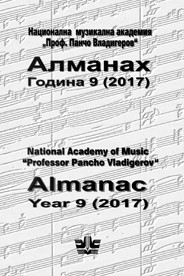Хипотези за броя и съдържанието на музикалните произведения на Филип Николай
Hypotheses Regarding the Number and Contents of Philip Nikolai’s Musical Works
Part 3. Second Polemic Song of Philipp Nicolai: “So wünsch ich nun eine gute Nacht” (“Thus I Wish a Good Night”)
Author(s): Mila NaumovaSubject(s): Fine Arts / Performing Arts, Music
Published by: Издателство НМА „Проф. Панчо Владигеров”
Keywords: Philipp Nicolai; “So wünsch”; 42nd Psalm; Geistreiches Gesangbuch; J. A. Freylinghausen; J. v Brandt; E. Mertel; L. Lechner
Summary/Abstract: This study is the sequel to the second part of the study “Hypotheses regarding the quantity and contents of the musical works of Philipp Nicolai (1566 – 1608)”. It examines the second of the alleged “polemic songs” of Nicolai to which notation is not found. Previous publications explain the setting of Nicolai’s life, times and the circumstances around his other unnotated musical output. Probably written during Nicolai’s voluntary exile at Unna during the plague outbreak of 1597, “So wünsch ich nun eine gute Nacht” (“Thus I wish a good night [to the world]”) features a complaining and politicized tone (a common denominator with the other “polemic song” of his, “Klagelied der Christlichen Kirchen zu Gott über die Calvinianer und Rottengeister, a sad song of the Christian churches about the Calvinists and the spirits of division”), at times nearing desperation of the evil, opposing the true Christianity, the corruption and abusiveness of Nicolai’s enemies. Biblical and folklore metaphors are employed to convey a vivid picture of the calamitous situation as perceived by the author. The method of finding relevant melodies relies on common words, phrases and in this case, a near mot-a-mot vernacular counterpart of the first line of Nicolai’s spiritual poem by the name of “So wünsch ich ihr ein’ gute Nacht” (“Thus I wish her a good night”). From that point of, the study examines available documents offering different melodies by various composers who have undertaken this material, as well as text differences, Finally, in an attempt to analyze the collected data, a table is comprised visually delineating the following: 1. Geographical location of where the composers and melodies were active (using symbols on a map of Central Europe). 2. Time (approximate years) of same. 3. Relationship between text and melody in terms of a successful (or less so) fusion, aiming to further illuminate any proof of a certain melody belonging to the poetry.
Journal: Алманах - Национална музикална академия „Проф. Панчо Владигеров“
- Issue Year: 2018
- Issue No: 9
- Page Range: 389-407
- Page Count: 19
- Language: Bulgarian

